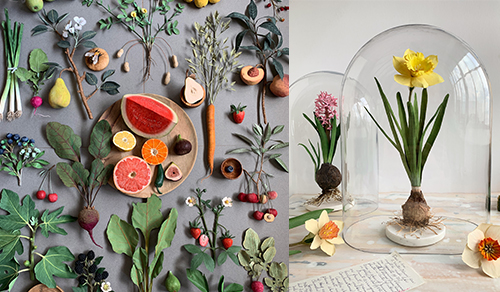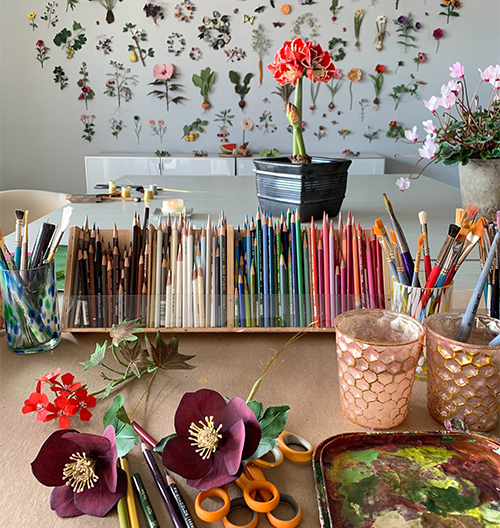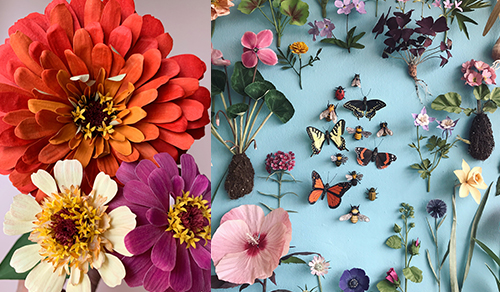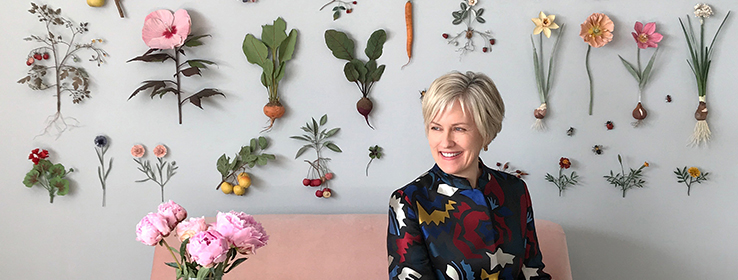Using wire, paper and paint, artist Ann Wood creates flowers and other plants that mirror colors from the garden.
Astounding as it sounds, Minneapolis artist Ann Wood started making paper flowers — beautiful pieces as shown on the wall in the image above — barely five years ago. Since then, she’s perfected her technique, painstakingly creating precise forms out of wire and paper, not to mention capturing nature’s colors with paint (including custom, flat-finish Sherwin-Williams hues). And even as those flowers have landed on the pages of Martha Stewart Living and in a museum show in the Netherlands, her work continues to evolve. STIR tapped Wood to learn more about her sources of inspiration and how they apply to the artist in all of us.
You’ve long been an artist, but the art of paper flowers is fairly new for you. What inspired you to explore that?
My dad was an old farmer, and in the last days of his life, he often talked about plants — and the beauty of nature would take him outside. I thought, there is something to this that is just universal. I had just started an Instagram account (@woodlucker) a few months earlier, and I could see people were starting to work on flowers with paper, so I thought I would give it a try. I developed my own techniques with unusual types of paper and paint that other people weren’t working in. And as the years have progressed, I’ve become more and more interested in the minute details that are in all of the plants that I create.

Fruits and vegetables round out artist Ann Wood’s creations of colorful plants, which primarily focus on flowers, including the hyacinth and daffodils shown here. All are made of paper.
Do botanical drawings serve as your reference?
I started out with looking at flowers in books, at vintage illustrations and photographs. And as it went along, it became more and more important to be working from the live plant. So now I grow almost everything in my garden or in my house that I then create. I dissect the plants and hand-paint all the paper. And Sherwin-Williams is one of the paints I’ve used — it’s been in my repertoire as an artist for 30 years. As I paint the paper, I match it to the color of the plants.
Today, I’ve started a new geranium. And if you look at a plant, even outside of the bloom, it can have seven or eight different colors. The stem might be a brighter green, whereas the leaves are a darker green. And what I do is flood the paper with a watery paint and keep adding layers to get it right. It’s just like choosing paint chips. It might need to go a little more yellow, or it might need to go a little more blue. So I keep over-painting on the paper with a watery paint to get the right color. I literally match it, eyeball it, to the plant.

Live plants, such as those shown at the center of the table in Wood’s studio, serve as reference materials for paper plants, including the stems sitting in the foreground and hanging on the wall.
How do you find the perfect paint to match?
Right now, I’m using a matte gouache and gesso, and some Golden Artist Colors products, to achieve my colors. But I also love the matte texture of a flat house paint. And for colors, I custom-mix them in these teeny plastic containers. I use primary colors just as you would a tube of artist acrylics, then white them out or gray them out a little bit to get the paint color I want.
Now, color is one part of the story. How about the way the plant literally takes shape?
I build all that up with wire and paint, and I do a lot of wrapping of different layers of paper around the wire to achieve the different volumes that everything needs to have. If something needs to go from a thicker stem to something real slender, this allows me to create a form that looks organic. Everything in nature has a lot of variation, so when I work, I’m looking at live plants to see how it all fits together. This year, everything I’ve made is based on what I’ve grown. I work with plants just as someone who draws a figure would work from a model.
You and your husband, Dean Lucker, have made art for years. What makes your work today different from what you’ve done before?
We made pinball games, dexterity games, mechanical cars — artworks that were based on toys that people could interact with. I’ve done a lot of different work, but I have to say that my work now is probably the most personally satisfying. And Instagram has been part of that, because for so much of my life, we just made things. We’d work for a year, and then we’d do a show. But it’s so lovely to constantly get to share my creations out to the world, and people get to see them and talk to me about them. As an artist, you spend so much time alone. And now I don’t ever feel alone with my crowd of people — the community that’s been built around my account — and my interactions with other accounts.

Zinnias (at left) and monarch butterflies (with other insects and blooms, at right) are some of Wood’s brightest paper pieces.
The way you used to display your works in frames and cloches changed thanks, in part, to those interactions, right?
Yes. My audience said, “You don’t really need to put these behind glass.” That planted a seed that I was going to make this giant wall of flowers. And I would say, “I want this wall to be in a museum,” just throwing out my biggest dream possible.
And what happened?
I ended up getting a call from the Netherlands one morning. A wonderful curator called me, and she said, “We need a paper botanical wall for a show of royal Delftware from the royal families of Europe at our museum in The Hague.”
That was for a show last year. With COVID-19, did the show go on?
Yes, we ended up setting up the show over Zoom. Then the show was open and closed. But it went on, and my work represented the florals that would have been in these large Delftware floral towers. They’re like pyramid towers, with 30–50 little holes. And out of each hole would have been a spectacular flower. But my work was in there because, of course, they couldn’t put any real flowers in these masterpieces.
Your flowers often steal quite a bit of the show. But you don’t stop with flowers.
Insects, for me, are the jewelry of the garden. They’re the pollinators, these little gems that can get added to the flowers. And then the garden makes food, too, so I’ve explored plants like grapes and onions. My work isn’t just flowers anymore — it really covers the abundant beauty of what is around us. And if we choose to stop and take a look, that beauty of nature is there as a gift at all times.
Photos by Woodlucker







